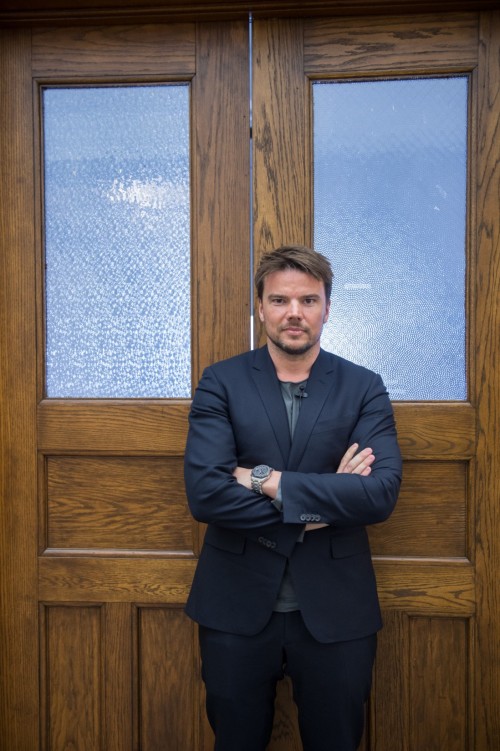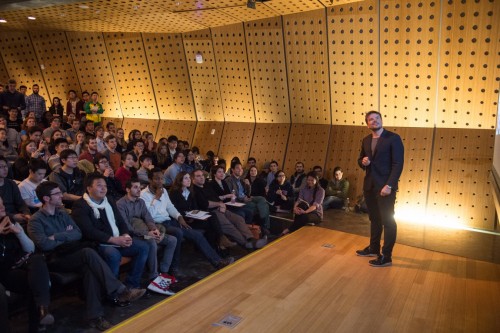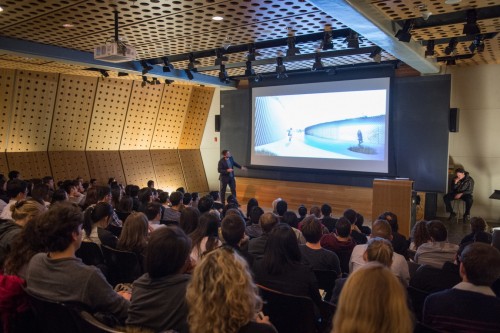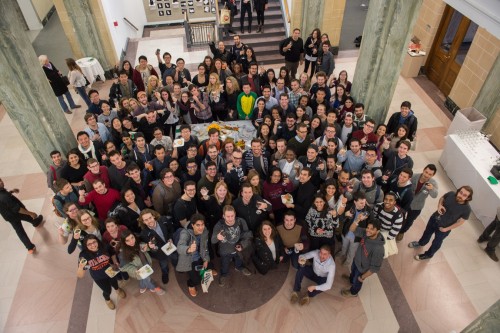Hundreds of students filled Slocum Auditorium on Tuesday evening–some stragglers even squeezed through the doors of the room trying to catch a glimpse of arguably one of the most well-known architects working today.
by Sydney Franklin, Goldring Arts Journalism Program
Bjarke Ingels may command a crowd with a rock star-like quality. He also might be one of very few designers whose signature is coveted by ambitious 18-year-olds. Yet despite his status, what makes the architect so accessible, as well as impressive, is his attitude.
When asked what he values in his team at Bjarke Ingels Group (BIG), Ingels emphasized the company’s commitment to being approachable and friendly.
“Being nice will get you so far,” he said in a conversation after the lecture. Even amidst flying back and forth between firms and projects in Copenhagen and New York, Ingels remains cheerful and anxious to study, problem solve, promote great design, and encourage young architects.
One of Ingels’ first and most profound memories from his early architectural education comes from an experience with his professor at the Royal Danish Academy of Fine Arts, Jens Thomas Arnfred, now at Tegnestuen Vandkunsten. During an introductory speech to the class, Amfred advised his students to do one thing by graduation: “I don’t really care if you learn anything that’s in the curriculum. The one thing that I really care about is that you promise me to leave this school with something in your heart.”
Ingels entered the realm of architecture as a hopeful cartoonist. Naturally gifted at drawing, he figured the next best career was in architecture. To develop his newfound passion for the built environment, he spent most of his time at the library, pouring over books detailed with extensive endnotes as well as magazines like El Croquis where he devoured monographs and interviews with architects.
“Drawing is what I could do. But what I couldn’t do or what I didn’t almost care about were buildings,” he said. “So I went through this serial monogamy of falling in love with one architect after another and I would study all the works and really get into the details of the plans and sections until I fully understood the project.”
Ingels called this a “reverse engineering” of his own curriculum, one based on interest and passion rather than requirement. The 40-year-old architect attributes some of his current success to taking himself seriously as a young designer. He even dropped out of the Escola Tècnica Superior d’Arquitectura in Barcelona for a time to start his own firm with friends after winning a competition.
“It was a complete disaster,” he said. “But the fact that we were outside a familiar context – I was 22 at the time – allowed us to take ourselves more seriously, in a way, because you could almost play a real architect.”
Ingels now manages a cross-continental firm that takes pride in its experiential atmosphere, seeking to take on projects that defy the very definition of architecture. Ingels’ designs are community-driven and conditionally focused, with attention to environmental pressures and innovations in technology. He’s also very passionate about investing in his interns, the up-and-coming architects who will further reinvent the field.
“As much as it is anything else, architecture is definitely a craft and the way you learn a craft is through apprenticeship,” he said. “And what this teaches you is co-authorship. If you don’t acquire those collaborative tools, skills and even the language you will be trouble once you enter the professional world because school will be the last time you’re ever going to do something on your own.”
Since his days as an intern at the Office of Metropolitan Architecture in Rotterdam (OMA), Ingels has learned how to effectively communicate his ever-growing knowledge of design. In closing remarks to the Syracuse architecture students earlier this week, he argued that “architecture is the art and science of turning fiction into fact.”
“We have the opportunity and responsibility to make the world a little more like our dreams,” he said. And in under a five hour bus ride from Syracuse, we can see Ingels’ dreams coming true on the West Side of Manhattan. As one of the youngest architects to ever build in New York, it’s no surprise that his talent has led to this high profile status. But what is striking is his sustained desire to build others up, instead of monopolizing all the attention.


















